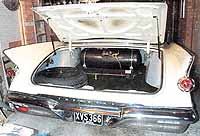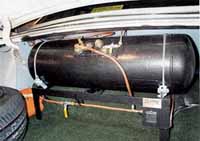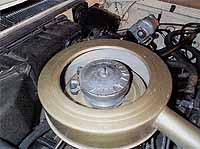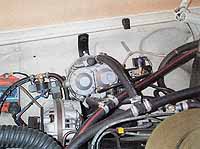

by Tony Vickers
Imperial Home Page -> Repair -> Fuel -> Conversion
(Click on the small images to see detailed pictures.)
Converting an Imperial to r un
on propane is a relatively simple affair and can be done by anyone with a
reasonable degree of mechanical ability. The cars most likely to be worth
converting are the older, full size gas guzzlers where fuel cost savings are
maximized and cavernous trunks allow plenty of space for the extra tanks. In
Europe and the U.K., this kind of conversion is increasing in popularity due to
the enormous differential between gasoline and propane prices. (Propane can cost
as little as one third of the price of regular gas in real terms). Bear in
mind that a well adjusted propane set-up will still burn about 10% more propane
than gasoline. However, if U.S. fuel prices continue to rise, the attractiveness
of propane increases.
un
on propane is a relatively simple affair and can be done by anyone with a
reasonable degree of mechanical ability. The cars most likely to be worth
converting are the older, full size gas guzzlers where fuel cost savings are
maximized and cavernous trunks allow plenty of space for the extra tanks. In
Europe and the U.K., this kind of conversion is increasing in popularity due to
the enormous differential between gasoline and propane prices. (Propane can cost
as little as one third of the price of regular gas in real terms). Bear in
mind that a well adjusted propane set-up will still burn about 10% more propane
than gasoline. However, if U.S. fuel prices continue to rise, the attractiveness
of propane increases.
Main parts required are 2 propane tanks, a gas regulator, an induction unit,
gasoline and propane control valves, LPG piping and a 3 way electric switch. I
believe the best known U.S. supplier of parts is the appropriately named Impco
company. Here in the U.K., I have used Italian made parts, but the principle is
the same.
I have found the
best location for the tanks is at the rear of the trunk under the parcel
shelf. Two 75 liter tanks are needed in order to provide enough capacity.
A tank should never be filled above 80% full, so two 75 liter tanks should
provide you with a 120 liter capacity. (75x2x80%) or about 31 U.S. gallons.
Tanks come in all shapes and sizes, so you can alter these requirements to suit
your individual needs, just as long as the tanks fit in the trunk. If you only
need a short range, one tank will do. When you buy the tanks, make sure the
supplier provides you with all the necessary inlet and outlet valves, including
a safety outlet valve that will shut down if the gas flow increases
dramatically. (This is in case of a pipe rupture)
 For obvious reasons, it is essential that the tanks are firmly secured in the
trunk. In order to achieve this some suppliers will offer a ready made steel
cradle, but if you can weld, or have access to a welding shop, it is a simple
and inexpensive matter to build a custom cradle out of angle iron to support
your tanks. The tanks can be secured to the cradle one in front of the other and
then the cradle can be slid onto the raised section of the trunk over the axle
and bolted in position., thus enabling you to remove the tanks at a later date
as a unit. I used steel cable tightened with fencing tensioners to attach my
tanks to the cradle. Although I have built a system which enables me to fill
both tanks from one filler valve, I would recommend from experience that it is
simpler and probably safer to have independent fillers for each tank. (The less
plumbing you do, the less chance of leaks). The only problem I encountered was
the trunk torsion bars under the parcel shelf got in the way of the tanks, so it
was necessary to remove them and fit a couple of gas struts to the trunk lid
which I picked up from a local breakers yard. Not exactly concours, but if you
are fitting a propane system, you are probably not going down that route anyway.
You may also have to remove the rear window air blower unit if you have one.
Filler valves can be fitted externally if needed and connected to the tanks via
LPG hose but for appearance sake, I built my filler valve into the tank cradle
in order to avoid unsightly external additions.
For obvious reasons, it is essential that the tanks are firmly secured in the
trunk. In order to achieve this some suppliers will offer a ready made steel
cradle, but if you can weld, or have access to a welding shop, it is a simple
and inexpensive matter to build a custom cradle out of angle iron to support
your tanks. The tanks can be secured to the cradle one in front of the other and
then the cradle can be slid onto the raised section of the trunk over the axle
and bolted in position., thus enabling you to remove the tanks at a later date
as a unit. I used steel cable tightened with fencing tensioners to attach my
tanks to the cradle. Although I have built a system which enables me to fill
both tanks from one filler valve, I would recommend from experience that it is
simpler and probably safer to have independent fillers for each tank. (The less
plumbing you do, the less chance of leaks). The only problem I encountered was
the trunk torsion bars under the parcel shelf got in the way of the tanks, so it
was necessary to remove them and fit a couple of gas struts to the trunk lid
which I picked up from a local breakers yard. Not exactly concours, but if you
are fitting a propane system, you are probably not going down that route anyway.
You may also have to remove the rear window air blower unit if you have one.
Filler valves can be fitted externally if needed and connected to the tanks via
LPG hose but for appearance sake, I built my filler valve into the tank cradle
in order to avoid unsightly external additions.
Having installed the tanks the next step is to fit the regulator. As with the
tank cradle, I built a heavy steel bar in the shape of an inverted T. I bolted
the regulator and all necessary valves relays and solenoids to this unit first
and then used one of the fender bolts to secure it to the inner wing of the car.
This way you don't need to drill unnecessary holes in your beloved Imperial and
the unit can be removed without disfiguring your car. The regulator will have a
water jacket which enables hot water from your engine to heat the unit and
prevent the propane from freezing in the lines, so you will have to cut into the
heater inlet and outlet hoses and connect the regulator water hoses via
"T" pieces.
In order to determine whether your car runs on gasoline or propane you will also
need two solenoid operated shut off valves, one for each type of fuel. If you
have an electric fuel pump the gasoline shut-off valve is not needed. You will
simply wire the electric pump via the 3 way switch inside the car. The propane
shut-off valve is located before the regulator and is connected via 6mm armored
copper pipe to the tanks in the trunk. From here the propane supply is directed
via the same type of 6mm pipe to the regulator. You must also break into the
existing fuel pipe and run it through the gasoline shut-off valve. Check all
propane pipe connections by dripping soapy water around the joint and looking
for bubbles.

The induction unit fits over the carburetor and inside the air filter. Fitting
this unit is very straightforward. Once fitted it can be connected via rubber
LPG piping to the regulator. If you want to avoid drilling the necessary holes
in your original air filter pan, an inexpensive after market unit will do.
In the picture to the right, I have removed the air filter so that you can
see the unit better and also the duct tape wrapped around the unit to restrict
the air flow. The area above the inlet pipes is left open. This has
reduced my gas consumption by about 40% and the car runs like a dream.
Finally, the electrics. Your propane parts supplier should be able to provide a
suitable relay to operate the solenoid controlled shut-off valves. The propane
valve should have a wire going to the coil. This is designed to shut down the
propane supply if the engine stops. If you are not sure you should also get a
wiring diagram from the supplier showing the right connections. Inside the car
you will need a 3 way switch enabling you to choose either gasoline or propane
or to switch off both valves together. This is particularly important with
mechanical fuel pumps and carburetors as the neutral position allows you to use
up the existing fuel in your carburetor before switching to propane. If you have
removed your rear air blower, the original switch may be ideal. It certainly was
on my '61 and avoided the need for a modern plastic switch. It is obviously
essential to wire the system so that it only operates when the ignition is on.
One problem I  encountered was that when I operated the starter, it drew so much power that the
propane solenoid failed to open and allow fuel to the induction unit. In order
to overcome this, I installed another relay which diverts power directly from
the battery to the propane valve solenoid when the starter is engaged. The
picture to the left shows (from left to right) the gasoline shut-off valve, the
power booster relay, the regulator and the propane shut-off valve.
Although it is hidden from view, the shut-off valve relay is immediately to the
right of the regulator. In the foreground you can see where the regulator
water jacket is plumbed into the heater hoses. In the bottom right hand
corner, the big brass screw is the propane mixture control. By suspending
the whole kit from the black "T" bar, and fastening it with the fender
bolt, I avoided drilling into the inner wing.
encountered was that when I operated the starter, it drew so much power that the
propane solenoid failed to open and allow fuel to the induction unit. In order
to overcome this, I installed another relay which diverts power directly from
the battery to the propane valve solenoid when the starter is engaged. The
picture to the left shows (from left to right) the gasoline shut-off valve, the
power booster relay, the regulator and the propane shut-off valve.
Although it is hidden from view, the shut-off valve relay is immediately to the
right of the regulator. In the foreground you can see where the regulator
water jacket is plumbed into the heater hoses. In the bottom right hand
corner, the big brass screw is the propane mixture control. By suspending
the whole kit from the black "T" bar, and fastening it with the fender
bolt, I avoided drilling into the inner wing.
Once the system is installed it may take a while to get the mixture balanced. I
have found that the air to propane mix is hugely different to the air to
gasoline ratio. The result is that propane consumption can be way to high. In
order to solve this problem, I reduced the air flow through the induction unit
by about three quarters by wrapping duct tape around part of the induction unit
air inlet. The result was a 40% improvement in propane consumption with no
performance drop. Incredible, but true. Naturally, if you then want to run on
gasoline the mixture will run too rich, but you can always remove the duct tape
if necessary. To achieve the best mixture and meet emission standards you should
hire an exhaust gas tester or find a testing station. It is surprising how lean
the propane supply has to be to provide good performance and good emissions.
The one overriding concern when installing a propane system is safety. A
properly fitted system should be no more dangerous than a regular gas tank, but
caution must be taken at all times when making joints, routing pipes and fitting
safety features. LPG operates at high pressure and in the event of a major leak,
even if it does not ignite, close exposure to escaping propane can cause severe
frost-bite. Always use approved LPG standard pipes and fittings.
This page last updated November 21, 2001. Send us your feedback, and come join the Imperial Mailing List - Online Car Club